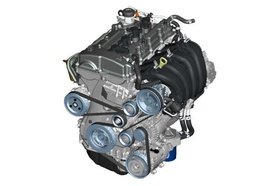Hyundai’s first Gasoline Direct Injection engine was unveiled today at the Ninth Annual Hyundai-Kia International Powertrain Conference. The event took place before an audience of engineers and it represents Hyundai’s plan of lowering emissions while improving fuel economy and torque.
Hyundai’s first Gasoline Direct Injection engine is a 2.4 Theta II GDI unit capable of generating 201 PS at 6300 rpm and 25.5kg.m at 4250 rpm and will initially be used in the 2010 Sonata.
Development for the company’s first Gasoline Direct Injection engine involved a budget of 170 billion and 46 months of research.
More specific details regarding Hyundai’s first Gasoline Direct Injection engine in the official press release below.
Hyundai press release :
(Namyang, Korea) To help meet its goals of environmental leadership, Hyundai Motor Company today unveiled the 2.4 Theta II GDI, its first Gasoline Direct Injection engine before an audience of engineers attending the Ninth Annual Hyundai-Kia International Powertrain Conference.
Representing the biggest advancement in fuel injection, an ‘80s technology that replaced the carburetor, GDI puts Hyundai at the cutting edge of engine design and management by achieving three seemly incompatible goals: GDI lowers emissions while raising power output and improving fuel economy. Prior to GDI, a gain in one area came at the expense of the other two.
With a compression ratio of 11.3:1, the 2.4 Theta II GDI delivers 201ps@6300rpm and 25.5kg.m@4250rpm in its Korean domestic market specification.
“The Theta II GDI convincingly demonstrates Hyundai’s advanced powertrain engineering capabilities,” said Dr. Lee Hyun-Soon, Vice Chairman and Chief Technology Officer.
Developed with a budget of 170 billion won over a 46 month-long research period, the new 2.4 Theta II GDI engine will make its debut in the first half of 2010 starting with the recently launched Sonata, beating the mid-size sedan competition to market with this exciting new technology. GDI application will subsequently be expanded across the gasoline engine family and applied to other Hyundai models.
One serious limitation of conventional fuel injection is that as engine revolutions increase, the valve opening and closing times get progressively shorter, thus reducing the time available to inject fuel. GDI avoids this problem altogether by positioning the fuel injector in the most optimal location, directly inside the combustion chamber to offer unparalleled precision. With this shorter and more direct path, far greater control is attained over the combustion process: A high pressure fuel pump injects the fuel at pressures of up to 150 bar, in precise amounts and intervals.
The injection is split into two phases to achieve optimum combustion: in the first phase, the pilot injection and ignition trigger the pistons downward power stroke. Then, in the main injection phase, during the pistons descent, more fuel is injected and is ignited. This split-injection technique reduces loading on the catalytic converter and helps lower emissions. This is particularly beneficial during cold starts when emissions are highest because the catalyst has not reached its optimal operating temperature. Split-injection enables the catalytic converter to reach the optimal operating temperature faster thus reducing emissions by 25 percent during cold starts and meet’s California Air Resources Board’s ULEV-2 and PZEV standards
GDI’s other benefits include improved dynamic performance and better gas mileage. Compared to a conventional engine of the same displacement, GDI delivers 7 percent more torque at low revolutions and 12 percent more torque at the high-end for better take-off and overtaking performance. And perhaps best of all, a vehicle equipped with a GDI engine will get about 10 percent better mileage than a vehicle equipped with a conventional multi-point fuel injected engine. Precise mileage figures will be announced when retail sales begin.
DI has been applied to the second generation of Theta: Theta II features numerous design enhancements over its predecessor starting with the application of a three-stage variable induction system (VIS) which improves engine "breathing," automatically adjusting the volume of the air sucked into the combustion chamber to create the "optimal" air-to-fuel mix under different engine load conditions.
Further performance gains were made possible by incorporating Dual Continuously Variable Valve Timing (DCVVT) which improves engine breathing on the intake and exhaust sides for better fuel economy and lower emissions. Depending on engine load and speed, DCVVT can extend or shorten the duration of the valve opening and closing for more power and lower emissions. And the DCVVT system is governed by a new steel chain with an innovative roller and tooth designed for silent operation and durability.
While DCVVT and VIS improve power output, engineers have also come up with several important weight saving innovations. Special attention was focused on the bulkhead, the area of the aluminium cylinder block accumulating the highest stresses: Reinforcement yielded a stiffer block without incurring a weight penalty. A redesign of the crankshaft (semi-eight-balance type) led to an equally important weight reduction. The catalytic converter is also lighter thanks to a new canning process which allows for the use of thinner gauge stainless steel and requiring far less welding.
Another major engineering challenge was to reduce internal friction to attain better fuel economy. Friction reduction measures include a revision of the piston pin from a fixed-type to a full-floating design which cuts down on friction between the piston and cylinder wall. And under the piston crown, engineers have added a cooling jet which sprays oil over the piston walls reducing friction and contributing to an improvement in fuel economy.
The Conference’s plenary session open today under the banner “Creative Sustainable Powertrain Evolution for Green Growth.” Wednesday will see a large number of technical presentations delivered in various sessions covering the future of gasoline engines, new developments in exhaust emission after-treatment, fuel efficiency improvement and transmissions. Some 600 specialists from Europe, Japan, the United States and Korea are attending this years event.

17 Nov 2009
0


